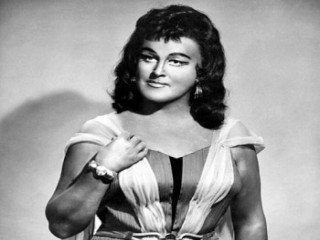
Birgit Nilsson biography
Date of birth : 1918-05-17
Date of death : 2005-12-25
Birthplace : Västra Karup, Sweden
Nationality : Swedish
Category : Famous Figures
Last modified : 2011-09-08
Credited as : dramatic soprano, symphonic,
0 votes so far
Born in 1918, Nilsson grew up on a farm in Västra Karup, in southern Sweden, on a parcel of land that had been tilled by five generations of her family before her father. She inherited her musical talents from her mother, an amateur singer, who gave her a toy piano on which the three-year-old Nilsson quickly proved adept at picking out melodies. Unlike many of her modern counterparts, she had very little formal training, save for some classes at the Royal Academy of Music in Stockholm in the early 1940s. She originally planned for a career as a concert singer, and gave a few performances before being drafted into taking a stage role in a Royal Opera of Stockholm event in 1946 as a last-minute replacement. The following year, she made her formal debut on the same stage in the Verdi opera Macbeth .
Over the next decade, Nilsson took on a series of progressively more challenging roles, and the steady development of her voice was said to have trained it well enough to make it strong enough for the more challenging Wagner roles that came later, as well as allow her to perform well into her sixties. She gained a fair amount of international attention in the opera world when she made her debut at the Glyndebourne Festival in 1951 in Britain, performing in Mozart's Idomeneo as Elettra. Three years later, she made her first appearance at Germany's Bayreuth Festival, the illustrious summer event founded by Wagner in 1876 as an annual showcase for his operas.
Nilsson's first performance in the United States came at the San Francisco Opera in 1956, followed by a Lyric Opera of Chicago appearance. A year later, she debuted at London's Covent Garden as Brünnhilde in Wagner's Die Walküre , from his legendary four-opera cycle Der Ring des Nibelungen . Her New York Metropolitan Opera debut as Isolde in Tristan und Isolde in 1969 made the front page of the New York Times the next morning, and from that point forward Nilsson was heralded as the opera world's leading Wagnerian soprano.
Wagner's operas were seemingly designed for only the heartiest of performers: They were lengthy events, with lead roles feared by singers as both difficult to master and punishing to the vocal cords. Furthermore, Wagner's music was written to be played loudly by the orchestra, which forced singers to compete to be heard above it. Nilsson had little trouble with any of those formidable requirements, and remained the best-known Wagnerian soprano on the international circuit throughout the 1960s and '70s. "Her stamina was inexhaustible, so that she appeared perfectly fresh at the end of the most gruelling performance," declared Elizabeth Forbes in London's Independent . "Her interpretations, those of Isolde and Brünnhilde in particular, grew steadily deeper in their dramatic insight."
Nilsson's career was not confined exclusively to Wagner's operas. She was also outstanding in the title role of Richard Strauss's Elektra , as well as in Turandot , a Puccini opera. But much of her career was devoted to the Wagner cycle, both on stage and in the recording studio. One of Nilsson's most impressive contributions to her art was a complete Ring cycle recorded for the Decca label, which was the first ever to be done of the series in the studio and took seven years to complete.
A tax battle with the U.S. Internal Revenue Service kept Nilsson from performing in the United States during for a number of years during the 1970s, but she was widely heard on the European stage. She penned an autobiography Mina Minnesbilder ("My Memoirs in Pictures"), published in 1977 and four years later in English translation, and by 1984 had formally retired from the stage and was teaching master classes. In 1996, at the age of 77, she appeared once again on the Metropolitan Opera stage for a gala honoring its longtime music director, James Levine, and spoke warmly of him before ending with a signature "ho-yo-to-ho," Brünnhilde's famous battle cry from Die Walküre .
Nilsson spent her remaining years on the Västra Karup farm, and died on Christmas Day of 2005 at the age of 87. The cause of death was unknown, but she was thought to have suffered from a heart ailment. She is survived by her husband, Bertil Niklasson, whom she had married in 1949; the couple had no children. Returning to her childhood home might have seemed an unusual way for the world's most famous soprano to spend her retirement, but Nilsson gave an interview a decade before her death in which she said, "I've always tried to remember what my mother used to tell me," the New York Times ' Bernard Holland quoted her as saying. "Stay close to the earth. Then when you fall down, it won't hurt so much."
















